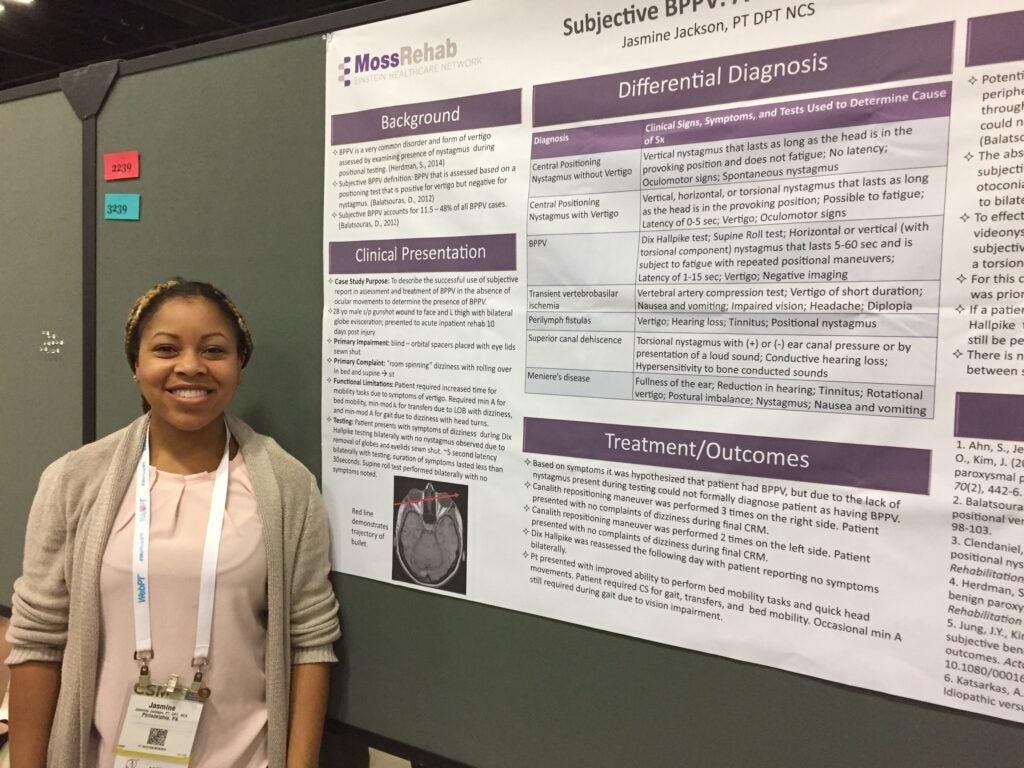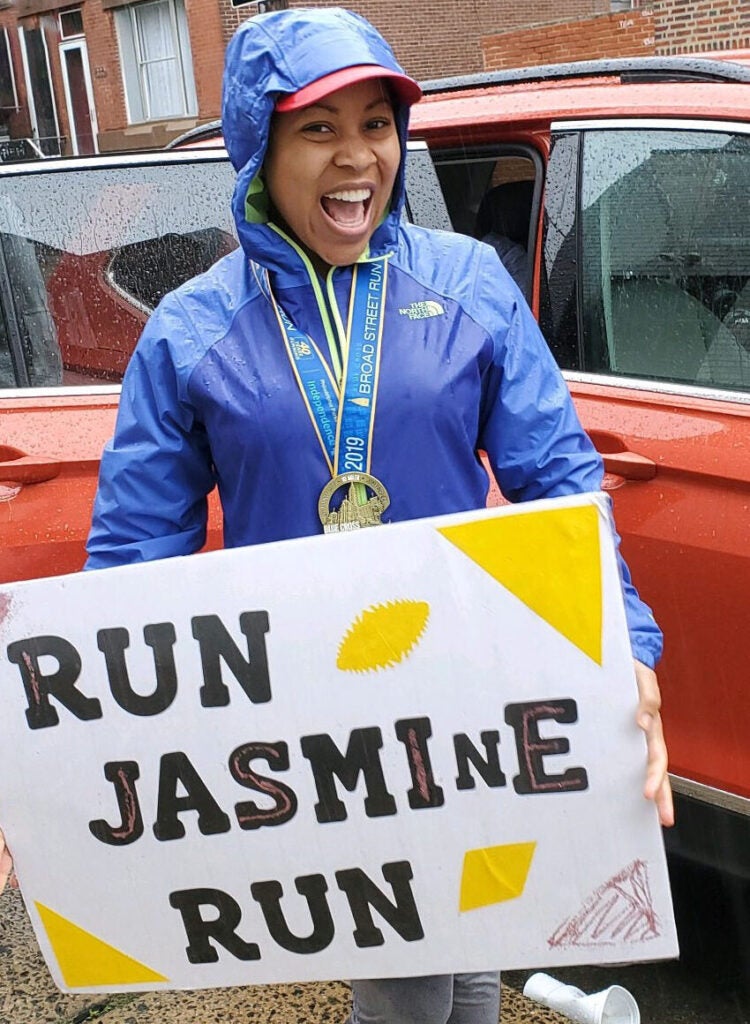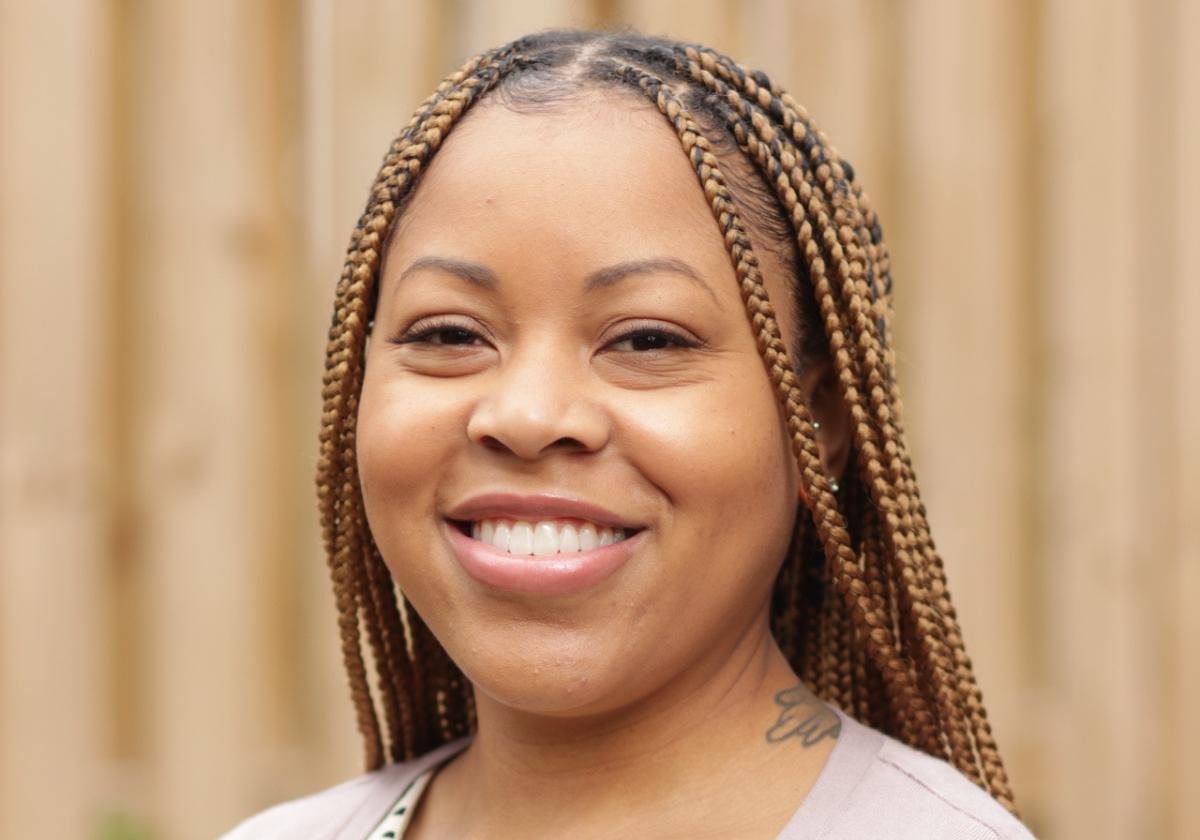Jasmine Edwards is an assistant professor in the Doctor of Physical Therapy (DPT) program at the School of Health and Rehabilitation Sciences. Based north of Philadelphia, Edwards started her role at Pitt in August of 2024, teaching in the hybrid option. Edwards provides students with a well-rounded and engaging education through a hybrid setting that prepares them for a future in the hands-on field of physical therapy (PT).
Read on to learn more about Edwards’ background and what she enjoys about being a physical therapist and an educator.
Discovering Physical Therapy
How did you get interested in physical therapy?

Growing up, my grandmother had rheumatoid arthritis, and I distinctly remember going to a physical therapy session with her and thinking the place was so fascinating. The summer before beginning my freshman year at the University of Maryland College Park, I was still undecided about what to study, so I entered into a scholar’s program for underrepresented minority students to explore different career options. Through that, I selected health care.
They had me shadow a nurse, a physical therapist and a primary care physician, and I loved getting to shadow the physical therapist the most. That experience prompted me to study kinesiology with a pre-physical therapy track. Later, I went on to Temple University to obtain my Doctor of Physical Therapy degree.
Coming to Pitt PT
What prompted you to become a faculty member at SHRS?

During my time as a student, my friends and I would study together, and they would make comments about how I was really good at explaining topics to them and breaking them down. I had never thought about teaching as a possible career path before then. In 2014, a year after I graduated from PT school, I went into a residency program at MossRehab (now known as Jefferson Moss-Magee Rehabilitation) and got more opportunities to teach. I began as an adjunct at Temple University and realized that teaching was a passion for me. In January 2020, I switched to full-time academia.
Kim Nixon-Cave, the director of the Pitt DPT hybrid option, had been a mentor to me before I came to Pitt, and when the opportunity arose within the hybrid option last year to join the faculty, it was just serendipity. Perfect timing.
What are the strengths of the Pitt DPT hybrid option?
I think the fact that Pitt’s hybrid option is embedded in the established residential program makes it so strong. A lot of the other hybrid programs popping up around the country are standalone options. Pitt’s hybrid option being based in such a strong residential program is beneficial because you’re getting the same experience, courses and information, just in a hybrid version.

Plus, Pitt brought on some of the strongest physical therapy educators in the field to develop the hybrid option. Our department leadership consists of strong PT educators who have extensive experience with the Commission on Accreditation in Physical Therapy Education. Pitt is unique in that many of its senior faculty, including leadership, are fellows of American Physical Therapy Association (APTA), which is one of the highest honors in the profession.
Recommending Residency
What was your residency experience like?
I completed a year-long residency with rotations across inpatient stroke, spinal cord injury, inpatient and outpatient brain injury, outpatient neurologic, outpatient vestibular dysfunction, and one week on the acute neurologic floor. The program was intense and included mentorship that challenged me and pushed me to grow. It significantly strengthened my clinical reasoning and decision-making, leading to me creating more effective plans of care and interventions for patients. The residency also taught me how to self-reflect more effectively, allowing me to improve myself still today.
How do you guide students on whether to pursue a residency?
The Doctor of Physical Therapy program at Pitt provides students with information about what a residency is and the benefits of completing one. But students have to find the right one for them on their own. APTA has a website that lists all the specialty areas and their accredited residency programs. It is a very competitive process as many residency programs take only 1-3 residents a year.
Completing a residency fast-tracks you to obtaining a specialist certification. A residency program gives you more dedicated and intense mentoring that can further improve your clinical skills. Additionally, you only work with patients in the specialty area you chose, unlike those not in a residency, where your caseload may only have a small percentage of patients within a specialty area.

However, I encourage students to think about their interests and whether they are ready for an intense year of focus and growth around a specialty area. A residency is an intense year, and if it’s something you’re not really interested in, it’s going to be a very hard year financially, personally and emotionally due to the amount of clinical and didactic work that must be completed within a short timeframe.
Because of this, I recommend that students work for at least a few months after graduation to gain autonomy and be sure they are genuinely interested and invested in their specialty area and understand the costs and time associated with a residency program.
Pursuing PT at the State Level
What is your involvement with physical therapy at the state level?
As a member of APTA Pennsylvania, I’ve had the opportunity to stay actively involved in the profession at the state level, particularly through my role as chair of the Minority Affairs Committee. In this position, I work with a passionate team of clinicians and students to help promote diversity, equity and inclusion within physical therapy across the state. Our committee supports underrepresented physical therapy and physical therapy assistant students through scholarship opportunities like the Minority Student Membership Award and the ADAPT grant. We also host events that bring people together such as student and clinician networking nights and Dine 4 Diversity, our annual fundraiser that helps raise money for student scholarships. We aim to create space for conversation, mentorship and support, while also raising awareness of systemic barriers in the profession.
Finding Fulfillment through Pitt PT
What do you find rewarding about a career in physical therapy?

As a neurologic clinical specialist, specifically working with people following a brain injury, stroke or vestibular dysfunction, I find it so rewarding to see someone come into inpatient rehab significantly impaired, and by the time they get to me in outpatient, they are moving around more independently. They might still have some impairments, but by the end of the course of care, they’re back to engaging in their different life roles. Especially in brain injury where it can be a much younger population and seeing the emotional toll it takes on the family members and caregivers, being able to see that positive progression over time and know that we as PTs helped with that transition is huge.
What do you enjoy about working at Pitt PT?
I see the students coming in during their first year and they’re nervous or intimidated by the courseload in front of them. Then by the third year, they’re confident, collected and knowledgeable. And they’re going to walk across the stage at graduation and be my colleagues. To see them change as people and professionals and knowing what they can contribute to the profession is really cool to see.
Fun Facts
What fun facts would you like students to know about you?

- Outside of working, family is a big part of my life. I have a three and a half-year old, a one year-old and a stepson who will be 21 this year. My fun time is the time I spend with them.
- I enjoy running, hiking, traveling and am getting good at tennis!
- I will be starting a PhD program in the spring in population health/epidemiology.


